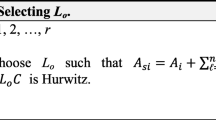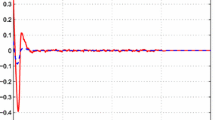Abstract
This paper investigates the problems of state/fault estimation and active fault-tolerant control (AFTC) design for time-delay descriptor fuzzy systems subject to external disturbances and actuator faults. Using Takagi–Sugeno fuzzy models, an adaptive fuzzy observer is proposed to achieve system state and actuator fault estimation simultaneously. According to Lyapunov functional method, design and analysis conditions of the resulting closed-loop delayed descriptor system are formulated in terms of linear matrices inequalities (LMIs). Observer and controller gains are computed by solving a set of LMIs in only one step and then used to both estimate the unmeasured states and actuator faults in AFTC context. Numerical examples are provided to show the merit and the conservativeness of the proposed approach in comparison with the existing methods by considering various types of actuator faults.










Similar content being viewed by others
References
M. Alma, M. Darouach, Adaptive observers design for a class of linear descriptor systems. Automatica 50(2), 578–583 (2014)
M. Blanke, R. Izadi-Zamanabadi, S. Bogh, C. Lunau, Fault-tolerant control systems—a holistic view. Control Eng. Pract. 5(5), 693–702 (1997)
Y.Y. Cao, P.M. Frank, Analysis and synthesis of nonlinear time-delay systems via fuzzy control approach. IEEE Trans. Fuzzy Syst. 8(2), 200–211 (2000)
M. Chadli, H.R. Karimi, Robust observer design for unknown inputs Takagi–Sugeno models. IEEE Trans. Fuzzy Syst. 21(1), 158–164 (2013)
M. Darouach, M. Boutayeb, Design of observers for descriptor systems. IEEE Trans. Autom. Control 40(7), 1323–1327 (1995)
B. Erkus, Y.J. Lee, Linear matrix inequalities and matlab lmi toolbox, in University of Southern California Group Meeting Report (Los Angeles, 2004)
H. Gassara, A.E. Hajjaji, M. Chaabane, Adaptive fault tolerant control design for Takagi–Sugeno fuzzy systems with interval time-varying delay. Opt. Control Appl. Methods 35, 609–625 (2014)
H. Gassara, A.E. Hajjaji, M. Chaabane, Observer based (Q, V, R)-\(\alpha \)-dissipative control for TS fuzzy descriptor systems with time delay. J. Frankl. Inst. 351, 187–206 (2014)
K. Gu, J. Chen, V.L. Kharitonov, Stability of Time-Delay Systems (Birkhauser, Boston, 2003)
J. Han, H. Zhangn, Y. Wang, X. Liu, Robust state/fault estimation and fault tolerant control for T–S fuzzy systems with sensor and actuator faults. J. Frankl. Inst. 353, 615–641 (2016)
Y. He, M. Wu, J.H. She, G.P. Liu, Parameter-dependent lyapunov functional for stability of time-delay systems with polytopic-type uncertainties. IEEE Trans. Autom. Control 49(5), 828–832 (2004)
Q. Jia, W. Chen, Y. Zhang, H. Li, Fault reconstruction and fault-tolerant control via learning observers in Takagi–Sugeno fuzzy descriptor systems with time delays. IEEE Trans. Ind. Electron. 62(6), 3885–3895 (2015)
D. Kharrat, H. Gassara, A.E. Hajjaji, M. Chaabane, Fault tolerant control based on adaptive observer for Takagi–Sugeno fuzzy descriptor systems, in 16th International Conference on Sciences and Techniques of Automatic Control and Computer Engineering (STA) (IEEE, 2015), pp. 273–278
D. Koenig, Observer design for unknown input nonlinear descriptor systems via convex optimization. IEEE Trans. Autom. Control 51, 1047–1052 (2006)
D. Koenig, S. Mammar, Design of proportional–integral observer for unknown input descriptor systems. IEEE Trans. Autom. Control 47(12), 2057–2062 (2002)
F. Li, P. Shi, C.C. Lim, L. Wu, Fault detection filtering for nonhomogeneous Markovian jump systems via fuzzy approach. IEEE Trans. Fuzzy Syst. (2016)
C. Lin, Q.G Wang, T.H. Lee, Stability and stabilization of a class of fuzzy time-delay descriptor systems. IEEE Trans. Fuzzy Syst. 14(4), 542–551 (2006)
C. Lin, Q.G. Wang, T.H. Lee, Y. He, LMI Approach to Analysis and Control of Takagi–Sugeno Fuzzy Systems with Time Delay, vol. 351 (Springer, Berlin, 2007)
B. Marx, D. Koenig, J. Ragot, Design of observers for Takagi–Sugeno descriptor systems with unknown inputs and application to fault diagnosis. IET Control Theory Appl. 1(5), 1487–1495 (2007)
S.M.D. Oca, V. Puig, M. Witczak, L. Dziekan, Fault tolerant control strategy for actuator faults using lpv techniques: application to a two degree of freedom helicopter. Int. J. Appl. Math. Comput. Sci. 22(1), 161–171 (2012)
M. Rodrigues, H. Hamdi, D. Theilliol, C. Mechmeche, N.B. Braiek, Actuator fault estimation based adaptive polytopic observer for a class of lpv descriptor systems. Int. J. Robust Non Linear Control 25, 673–688 (2015)
Q. Shen, B. Jiang, V. Cocquempo, Fuzzy logic system-based adaptive fault-tolerant control for near-space vehicle attitude dynamics with actuator faults. IEEE Trans. Fuzzy Syst. 21(2), 289–299 (2013)
J. Wang, H\(_\infty \) fault-tolerant controller design for networked control systems with time-varying actuator faults. Int. J. Innov. Comput. Inf. Control 11(4), 1471–1481 (2015)
D. Xu, B. Jiang, P. Shi, Nonlinear actuator fault estimation observer: an inverse system appraoch via a T–S fuzzy model. Int. J. Appl. Math. Comput. Sci. 22, 183–196 (2012)
S. Xu, J. Lam, Robust H\(_\infty \) control for uncertain discrete-time delay fuzzy systems via output feedback controllers. IEEE Trans. Fuzzy Syst. 13(1), 82–93 (2005)
F. Yi-Fu, Z. Xun-Lin, Z. Qing-Ling, Delay-dependent stability criteria for singular time-delay systems. Acta Autom. Sin. 36(3), 433–437 (2010)
K. Zhang, B. Jiang, V. Cocquempot, Adaptive observer-based fast fault estimation. Int. J. Control 6(3), 320–326 (2008)
K. Zhang, B. Jiang, P. Shi, A new approach to observer-based fault-tolerant controller design for Takagi–Sugeno fuzzy systems with state delay. Circuits Syst. Signal Process. 28, 679–697 (2009)
M. Zhang, X. Shen, T. Li, Fault tolerant attitude control for cubesats with input saturation based on dynamic adaptive neural network. Int. J. Innov. Inf. Control 12(2), 651–663 (2016)
Z. Zuo, Y. Wang, Robust stability and stabilisation for nonlinear uncertain time-delay systems via fuzzy control approach. IET Control Theory Appl. 1(1), 422–429 (2007)
Author information
Authors and Affiliations
Corresponding author
Appendices
Appendix A: Proof of Theorem 1
Consider the following Lyapunov–Krasovskii functional:
The time derivative of V(t) is given by:
By using Lemma 1, we have:
where
By using (23) and substituting (22), (17) and (39) into Eq. (38), one can obtain:
Applying Jessen’s inequality [9] to deal with the cross product items, we obtain
Noting the extended state vector as follows:
Then, we can write :
where
Denote
where
By using Schur complement, inequality (25) is equivalent to \(\xi ^ T \phi _{i}^{11} \xi (t) + h^2[(E\dot{x}(t))^\mathrm{T} Z_1 (E\dot{x}(s))] + h^2 [\dot{e}_{x}^\mathrm{T}(s) Z_2 \dot{e}_x(s)] < 0\).
If condition (25) holds, it follows from (41) that
where \(\zeta =\lambda _\mathrm{min}(-\phi _i)\)
It follows that \(\dot{V}(t) \leqslant 0\) for \( \zeta \Vert \xi (t) \Vert ^2 > \delta \), and according to Lyapunov stability theory, \(\xi (t)\) will converge to a small set \(\Psi = \{ \xi (t) / \Vert \xi (t) \Vert ^2 \le \frac{\delta }{\zeta } \}\) ; thus, \(\xi (t)\) is uniformly bounded.
The proof is completed.
Appendix B: Proof of Theorem 2
We can write inequality (26) in this form
where
Consider the following symmetric matrix:
where \( \mathbb {Z}_{11} =\hbox {diag}(P_1^{-T},P_1^{-T}), \mathbb {Z}_{22} = \hbox {diag}(P_1^{-T},I,I,I)\) and \(\mathbb {Z}_{33} =P_1^{-T} \)
We can transform inequality (50) by pre- and post-multiplying it by \(\mathbb {Z}\), and we obtain this form:
By using Lemma 2, we obtain the following inequalities:
By applying Schur complement, we obtain the following inequality:
By posing \(X_1=P_1^{-1}, X_2=P_2, \widetilde{Z}_1=P_1^{-1}Z_1 P_1^{-T}, \widetilde{Q}_1=P_1^{-T}Q_1 P_1^{-1}, Y_{1i}=P_2 L_{1i}, Y_{2i}=P_2 L_{2i}\) and \(W_i=K_{i} P^{-1}_1\), we obtain inequality (30).
The proof is completed.
Rights and permissions
About this article
Cite this article
Kharrat, D., Gassara, H., El Hajjaji, A. et al. Adaptive Fuzzy Observer-Based Fault-Tolerant Control for Takagi–Sugeno Descriptor Nonlinear Systems with Time Delay. Circuits Syst Signal Process 37, 1542–1561 (2018). https://doi.org/10.1007/s00034-017-0624-4
Received:
Revised:
Accepted:
Published:
Issue Date:
DOI: https://doi.org/10.1007/s00034-017-0624-4




